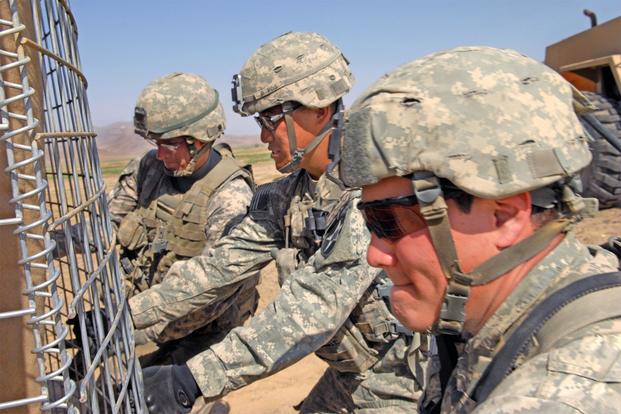Lawmakers want the Army to finalize a plan to dye its pixelated Universal Camouflage Patterned uniforms and equipment to blend with the service's new Operational Camouflage Pattern.
The House Armed Services Committee's subcommittee on readiness released its markup today for the proposed fiscal 2019 National Defense Authorization Act. The document expresses interest in technologies that would allow the Army to re-dye existing universal camouflage uniforms and equipment, with a particular focus on its never-popular, now-obsolete UCP camo.
The Army selected the Operation Camouflage Pattern -- a blend of browns, greens and tans -- to replace the older UCP pattern in 2014 as a result of the service's exhaustive camouflage study.
The Army is scheduled to transition over to the OCP uniform in October 2019, but the service still "possesses a substantial inventory of now obsolete UCP products," according to the document.
Program Executive Office Soldier is currently looking at overdye technologies and processes that could save the Army money by converting stocks of UCP uniforms and equipment to better blend with the OCP, the document states.
"This evaluation could validate processes that could alter UCP printed products into a color palette that blends with the new camouflage prints, allowing the Army to conserve resources by overdying UCP materials for use with OCP patterned equipment," the markup states.
The proposed markup "directs the Secretary of the Army to provide a briefing to the House Committee on Armed Services not later than August 31, 2018, that includes any current efforts to repurpose and field UCP personal equipment, any evaluations of overdye technologies and processes, and a business case analysis of fielding these overdye technologies and processes."
The new OCP is very similar to MultiCam, the pattern the Army chose in 2010 for soldiers to wear in Afghanistan.
The Army first launched its effort to find a replacement for the Universal Camouflage Pattern in 2009, after soldiers criticized the pixelated pattern for its poor performance in Afghanistan.
The effort evolved into a search for an Army-wide replacement pattern. The service ultimately tested numerous patterns in a variety of operational environments.
Some test community officials maintain that the 2004 adoption of the UCP was a mistake that could have been avoided, and billions of dollars could have been saved, if PEO Soldier had done better testing to back up its selection of UCP.
Two separate studies performed by Army scientists from Natick Soldier Systems Center, Mass. -- one completed in 2009 and the other in 2006 -- showed that the UCP performed poorly in multiple environments when compared to other modern camouflage patterns.
In both studies, the UCP performed poorly compared to MultiCam.
-- Matthew Cox can be reached at matthew.cox@military.com.










